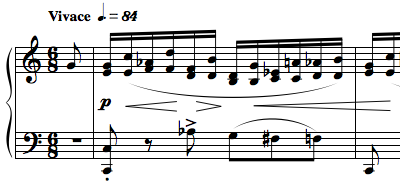
Étude Op. 10, No. 7 (Chopin)
Encyclopedia

C major
C major is a musical major scale based on C, with pitches C, D, E, F, G, A, and B. Its key signature has no flats/sharps.Its relative minor is A minor, and its parallel minor is C minor....
, is a solo piano
Piano
The piano is a musical instrument played by means of a keyboard. It is one of the most popular instruments in the world. Widely used in classical and jazz music for solo performances, ensemble use, chamber music and accompaniment, the piano is also very popular as an aid to composing and rehearsal...
technical study composed by Frédéric Chopin
Frédéric Chopin
Frédéric François Chopin was a Polish composer and virtuoso pianist. He is considered one of the great masters of Romantic music and has been called "the poet of the piano"....
in 1833. The tempo Vivace
Vivace
Vivace is Italian for "lively" and "vivid". It is pronounced in the International Phonetic Alphabet.Vivace is used as an Italian musical term indicating a movement that is in a lively mood ....
indicates a lively playing speed.
Structure
Conforming with most of the others, Étude Op. 10, No. 7 consists of three sections. The first themeTheme (music)
In music, a theme is the material, usually a recognizable melody, upon which part or all of a composition is based.-Characteristics:A theme may be perceivable as a complete musical expression in itself, separate from the work in which it is found . In contrast to an idea or motif, a theme is...
in C Major is followed by a short second theme in D major
D major
D major is a major scale based on D, consisting of the pitches D, E, F, G, A, B, and C. Its key signature consists of two sharps. Its relative minor is B minor and its parallel minor is D minor....
, which returns to the first theme. It is an exercise in interval
Interval (music)
In music theory, an interval is a combination of two notes, or the ratio between their frequencies. Two-note combinations are also called dyads...
s, with the right hand constantly changing from minor thirds to augmented sixths, in quick sixteenth note
Sixteenth note
thumb|right|Figure 1. A sixteenth note with stem facing up, a sixteenth note with stem facing down, and a sixteenth rest.thumb|right|Figure 2. Four sixteenth notes beamed together....
rhythm, while the left hand plays a simple bass harmonious accompaniment.
Technique
In order to be melodically pleasing, Étude Op. 10, No. 7 demands a special technique, as the interpretation of its melodic line is not as easy as the more popular études by Chopin; consequently, it is not a standard in concert repertoire. However, technicians, in particular Abby WhitesideAbby Whiteside
Abby Whiteside was an influential and controversial American piano teacher. She challenged the finger-centric approach of much classical piano teaching and instead advocated a holistic attitude in which the arm and torso are the conductors of a musical image conceived first in the mind and...
, favored this piece for its note structure and challenging execution. She states that it is impossible to play this without following her pedagogy, demanding that each note be played by action of the upper arms. It is, however, possible to master it without following her methodology.

